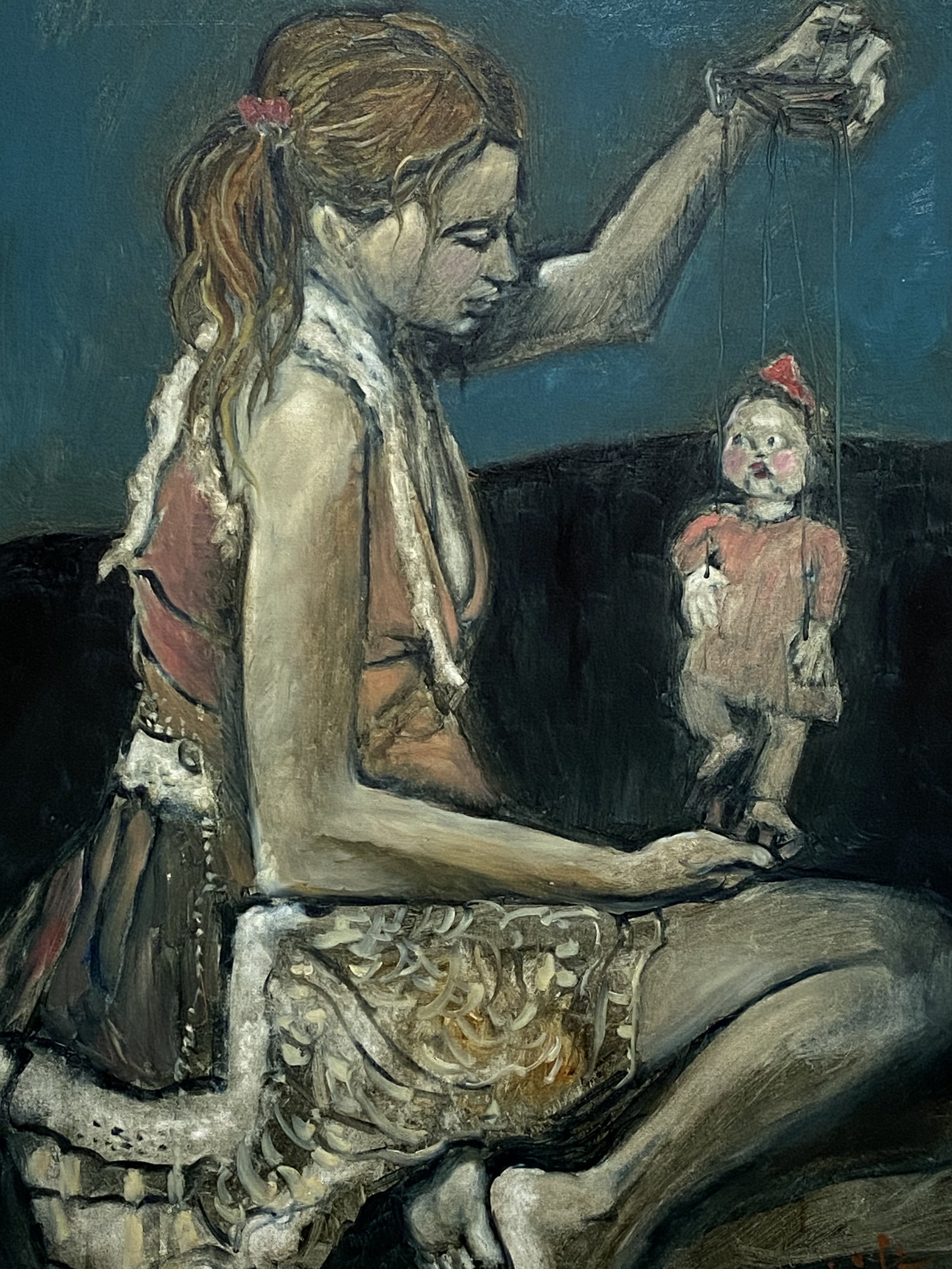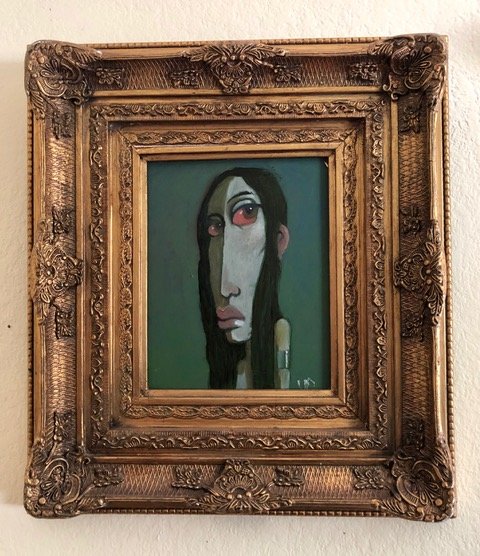A Legendary Conversation with Stanley Mouse
Photograph of Stanley Standing in front of two of his paintings “Wild Skeleton” ( left ) and “The Hitchhiker” (right) ©S.Mouse
Stanley Mouse is an American artist known for his vivid imagery, iconic posters, album covers, and contributions to the culture. He began his career in the late 50s when his artistic journey took a significant turn in 1958 when he passionately delved into the weirdo hot rod art world. This unconventional art form captivated Mouse. With unwavering dedication, he mastered the airbrush technique, painting T-shirts at custom car shows. It was at one of these shows that he fortuitously crossed paths with Ed Roth, the leading figure in Weirdo Hot Rod art. This encounter sparked a wise-cracking competition where he called him rat fink, and Mouse called him Bigg Fatty. In 1964, he was invited to help design car model kits with manufacturers such as Monogram Automobile, and he started using his model kits under the "monster" cartoon characters he had developed.
Mouse embarked on a new chapter in 1965 when he and a group of art school friends found themselves in San Francisco. First landing in Oakland, Mouse met Alton Kelley, a self-taught artist. Starting in 1966, Mouse did posters for Avalon Ballroom; in 1967, Mouse and Kelley worked out of an old horse-drawn firehouse and created works. Mouse lived and worked at 715 Ashbury across the street from 710 Ashbury, where members of The Grateful Dead resided. Kelly joined a group of longhairs that called themselves the Red Dog Saloon gang. They got together when Kelly came back, and Kelly became Art Director of the Family Dog. They embarked on their Journey of producing rock music dances. This led to Kelley and Mouse working together to make posters, which later led to producing posters for legendary promoter Bill Graham and other events in the psychedelic community. Between September 1967 and December 1967, the pair created psychedelic posters for shows at Helms' The Family Dog Denver. Mouse, Kelley, and their fellow San Francisco poster artists spearheaded a graphic revolution that not only reshaped the world of visual arts but also inspired a new generation of artists and art enthusiasts.
The artistic collaboration between Mouse and Kelley was not just about creating art but about reflecting a cultural revolution. Mouse's heavy influence from Art Nouveau graphics, particularly the works of Alphonse Mucha and Edmund Joseph Sullivan, combined with their inspiration from materials associated with psychedelics, such as Zig-Zag rolling papers, led to the creation of unique and resonating art. Their posters advertised for musical groups like Janis Joplin, Steve Miller, Jimi Hendrix, The Rolling Stones, Big Brother and the Holding Company, Quicksilver Messenger Service, and the Beatles. And Grateful Dead were not just advertisements but visual representations of the music. Their art resonated with the music, creating a unique and profound artistic experience. In 1969, Stanley was commissioned by Eric Clapton to paint his car in London. Years later, Mouse reconnected with Kelley after returning from London. They resumed their creative partnership, resulting in the production of iconic commercial artwork related to the Grateful Dead and later Journey. They are credited with creating the iconic skeleton and roses image that became the Grateful Dead's signature iconography. They also created Journey's Wings and Beetles, which appeared on their LP covers from 1977 to 1980.
I had the honor and privilege of asking Stanley about his artistic Journey. Where I asked about his favorite cover he had ever done, the first concert he attended, the origin of his nickname 'Mouse, 'his artistic ties to the Grateful Dead, and much more. This interview provides an insight into the life and work of this iconic artist.
UZOMAH: How did you get the nickname Mouse?
STANLEY: In the seventh grade, my buddy called me Mouse Hole Miller. I said drop the hole, and I’ll take it. I started signing my drawings mouse and became instantly famous in the seventh grade.



U: How did the Weirdo hot rod art movement in California impact your artistic inspirations?
S: I was born in California but raised in Detroit. Detroit was full of great music and cars. There was Mad Magazine, and I started drawing monsters. I always watched the fads that were coming out of California. Hot rod magazines were full of new things. Monte’s decals were the first to hit—the first weirdos. Then pinstripers like Jeffries started airbrushing shirts—weirdo shirts. I instantly got an airbrush.
Jerry Garcia Band Album Cover : Cats Under The Stars © 1978 Stanley Mouse
U: What are some benefits and disadvantages of creating art with a computer?
S: We did all our posters and album covers without computers. Actual physical artwork. The posters were made with pen and ink. The album covers were complex airbrush frisket work. And then finished with handwork. When the computer came out, I was very interested. I took up digital and, at the same time, dove into classical painting. I still do my art manually and compose it on a computer.
Joan Baez Poster : Peace © Stanley Mouse for the Mount Tam Outdoor Theater
U: When did you start using your art to interpret musical acts?
S: I always followed black music from when it was banned from white society. After psychedelics showed up, I expanded my art into music. I did a cover for Smokey Robinson’s Mickey’s Monkey. Then, I dropped out of art school and left for California.
Edwardian Ball - Jefferson Airplane poster for Edwardian Ball ©1966 S.Mouse
U: Can you discuss how your artistic partnership with Alton Kelley began? What was the joint inspiration for creating the skeleton and roses image that became the Dead's archetypal iconography?
S: In California, they were having great parties that got bigger and bigger until they had to rent a hall. Then, they needed posters for the events. This I could do.
Kelley was the art director of these posters. He hired me, and then we got together. He had a great idea, and I had the hand of an Olympic athlete from painting thousands of airbrushed shirts. The rest was history. From the posters, we went on to record covers.
The Grateful Dead skull and roses poster came from the Rubiat of Omar Khayyam. So, one day, when we had to do a dead poster, we were at the San Francisco library looking for ideas. We came across that design in a book, and both exclaimed that it had Grateful Dead all over it. Kelley cut it out with his penknife, and I colored it in and lettered it. Years later, I fessed up at a library talk. Kelley was gone, and they didn’t really care.
Easy Rider- Painting by Stanley Mouse ©Stanley Mouse
U: Who was the first band you saw live?
S: My first band was probably a Motown band. In their heyday, I used to paint shirts at the Detroit State Fair in front of the Motown band shell. I airbrushed in fluorescent colors, and I was always puffing on some weed; I didn’t think life could get any better than that.
No Mistakes - Painting by Stanley Mouse 2018 ©S.Mouse
U: What is the cover of your favorite album you created during your career?
S: My favorite album cover has to be either Journey Escape or Steve Miller's Book of Dreams.
For more information about Stanely’s artwork and career, please visit his website here. He can also be found on Facebook here and Instagram here. The Animazing Gallery's "Visions of the Dead: A Grateful Dead Art and Photography Exhibition, "which includes Mickey Hart, Jay Blakesberg, a long-time photographer for the band, photographer Chloe Weir, and Stanley’s artwork, will also be on display. The exhibition will open on May 14 and run through July 14. Mouse, Blakesberg, and Weir are scheduled to appear on Saturday, June 1, from 1 p.m. to 3 p.m. For more information about the exhibition, please visit the gallery’s website here.





